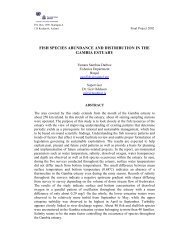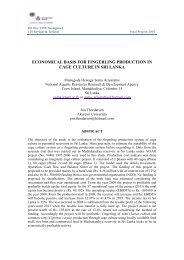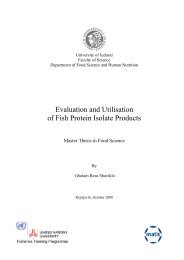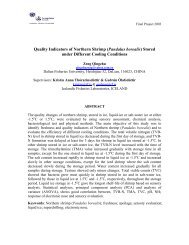a compliance study of Bangladesh shrimp aquaculture - The United ...
a compliance study of Bangladesh shrimp aquaculture - The United ...
a compliance study of Bangladesh shrimp aquaculture - The United ...
Create successful ePaper yourself
Turn your PDF publications into a flip-book with our unique Google optimized e-Paper software.
Seraj5 SHRIMP AQUACULTURE PRACTICES IN BANGLADESH<strong>The</strong> <strong>shrimp</strong> <strong>aquaculture</strong> <strong>of</strong> <strong>Bangladesh</strong> has a long history. Hundreds <strong>of</strong> years ago, the coastalpeople started using the tidal water within the paddy fields during January to June for<strong>aquaculture</strong>. <strong>The</strong>re was no fry stocking, no artificial feeding, liming, fertilization or aeration.<strong>The</strong>y used to trap tidal water harvest <strong>shrimp</strong> and finfish after two to three months time. Onlythe wild seeds <strong>of</strong> <strong>shrimp</strong> and fish carried by tidal water were allowed to grow without anyintervention. <strong>The</strong> production <strong>of</strong> <strong>shrimp</strong> was very low at that time. But they got sufficient fishand <strong>shrimp</strong> for their consumption. By the late 1960’s, almost all the canals and small andmedium sized rivers were closed by cross dams because <strong>of</strong> construction <strong>of</strong> embankmentsthrough the coastal belt to protect intrusion <strong>of</strong> saline water into rice fields.5.1 Development PhaseAfter the independence <strong>of</strong> <strong>Bangladesh</strong> in 1971, people grew interested in increased <strong>shrimp</strong>production because <strong>of</strong> increased price and demand in the international market. Some localpeople forcibly cut open the embankments in some areas and started <strong>shrimp</strong> culture in theirrice fields. From the late seventies or early eighties, the <strong>shrimp</strong> culture expanded steadily. Inaddition to trapping natural <strong>shrimp</strong> seed, farmers started stocking <strong>of</strong> Bagda (Panaeusmonodon) PL caught from the rivers and coast line. Since then there has been a continuousexpansion <strong>of</strong> <strong>shrimp</strong> farming area and production (Figure 6). Before 1980, <strong>shrimp</strong><strong>aquaculture</strong> area was only 20,000 ha, in 30 years it expanded 10 fold and presently 217,877 ha(Karim, 1986 and DoF, 2008b).Figure 6: Increase <strong>of</strong> <strong>shrimp</strong> farming area <strong>of</strong> <strong>Bangladesh</strong>, 1980-2007 (DoF 2008b)Shrimp production before 1980 was low. It started increasing rapidly during the 1990’s and itstill increasing in a good pace (Figure 7). During the last 30 years, <strong>shrimp</strong> production from<strong>aquaculture</strong> has increased more than five fold, from 14773 mt in 1986-87 to 86840 mt in thefiscal year 2006-07 (DoF, 2008b).UNU-Fisheries Training Programme 22
















